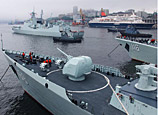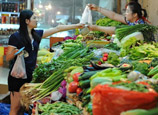
Inflation rose by more than expected in June but factory-gate deflation persisted, official data showed Tuesday, so monetary policy is unlikely to change at the moment, economists say.
The consumer price index (CPI), a main gauge of inflation, accelerated to 2.7 percent in June from a year ago, hitting the highest point since February this year, according to data released Tuesday by the National Bureau of Statistics (NBS).
The inflation rate is still below the government's target of 3.5 percent and also below the benchmark one-year deposit rate of 3 percent.
The bump in June CPI was mainly driven by food and housing rent, which rose by 4.9 percent and 4.1 percent, respectively.
However, the producer price index (PPI), which measures changes in price from the sellers' perspective, fell by 2.7 percent year-on-year, reflecting a decline in producer prices for a 16th consecutive month.
The fall was less than the 2.9 percent drop in May.
"The divergence of the CPI and PPI indicates that the general public are still feeling the pinch of inflation and that manufacturers are also having a hard time," Liu Xintian, chief analyst at SunSirs China Commodity Data Group, a commodities information provider, told the Global Times Tuesday.
Prices of commodities including rubber, gold, copper and coal extended a fall since February, because of weak demand and overcapacity issues in China, he said.
The falling trend for prices of raw materials will continue through to year-end, judging by the government's signals and the outlook for global growth, Moody's Investor's Service told the Global Times in a research note Tuesday.
"We expect monetary policy to remain 'prudent' with a bias toward tighter liquidity in the second half of this year from the first half of the year," said Chang Jian, China economist at Barclays Capital.
Reserve requirement rate cuts are neither desired by the central bank nor justified by the current economic conditions, she said.
The inflation rate is expected to remain at around 2.7 percent in the third quarter, and then climb to above 3 percent in the fourth quarter, which will limit the ability of the central bank to cut the current one-year benchmark deposit rate, said Zhang Zhiwei, chief China economist of Nomura Securities.
"Rising inflation limits the room for policy easing and reinforces our view that credit and money growth will continue to slow in coming months," he said in a research note Tuesday.
There are not likely to be any easing measures, Lu Ting, China economist at Bank of America Merrill Lynch, told the Global Times in a research note on Tuesday.
This is partly due to acceptance of a new era of slower growth, but also the need to control debt growth and the task of curbing the rise in home prices, Lu noted.
China has maintained an official GDP growth target of 7.5 percent for 2013, unchanged from 2012 when the government cut the target for the first time in eight years from a longstanding annual goal of 8 percent.
Many foreign financial institutions, including Citigroup, Barclays, Morgan Stanley, and UBS, recently lowered their forecasts for China's growth, as they expect the country's new leaders to take a different policy path from their predecessors by emphasizing de-leveraging, an absence of stimulus, and structural reform.
















 Severe rainstorms batter SW China quake-hit regions | Pedestrians fall into river after bridge collapses
Severe rainstorms batter SW China quake-hit regions | Pedestrians fall into river after bridge collapses


![]()
